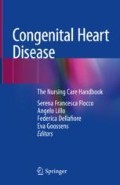Abstract
Technically, paediatric rehabilitation is not different from adult rehabilitation. The main difference consists in the possibility of establishing a verbal communication. This is difficult, if not impossible, in the paediatric patient since the abilities of verbal expression and comprehension are not completely developed, especially during the neonatal period.
The main purpose in the context of paediatric cardiac surgery is to guarantee the patient a better future quality of life. Recognizing the clinical conditions of rehabilitative interest and the management of anxiety and fears of the relatives of the young patients represents additional difficulties. The fundamental difference with the adult patient is that this one can communicate his or her own perceptions, fears, difficulties and hopes but even his or her own symptoms. So the keywords in the rehabilitative treatment of the newborn are imagination and simplicity. The treatment includes the aid in enforcing motoric planning and execution. In paediatric rehabilitation, careful observation is one of the central competences of the physiotherapist [1].
Access this chapter
Tax calculation will be finalised at checkout
Purchases are for personal use only
References
Giornale italiano di cardiologia. Vol. 15. aprile 2014.
Schaaf RC, Sherwen LN, Youngblood N. An interdisciplinary, environmentally-based model of care for children with HIV infection and their caregivers. Phys Occup Ther Pediatr. 1997;17(3):63–85.
Zuffo S. La fisioterapia respiratoria disostruente con PEP mask nel lattante e nel bambino non collaborante (cerebropatie di varia natura). Quaderni AITR. 1995;9(1–8):15–22.
Jenkins SC. Chapter 8: Pre-operative and post-operative physiotherapy—are they necessary? In: Respiratory care. Churchill Livingstone; 1991. p. 147–68.
Terry PB, Traytsman RJ, Newball HH, et al. Collateral ventilation in man. N Engl J Med. 1978;298:10–5.
Zuffo S. Fisioterapia respiratoria in terapia intensiva neonatale (TIN). Boll ARIR. 1996; anno 5, n. 1:11–20 e 27–8.
Review Article “Pediatric cardiac surgery: what to expect from physiotherapeutic intervention?” Braz J Cardiovasc Surg (Rev Bras Cir Cardiovasc). 2011;26(2). São José do Rio Preto Apr./June 2011.
Leininger M, Mcfarland MR. Transcultural nursing: concepts, theories, research and practice. 3rd ed. New York: McGraw-Hill; 2002.
World Health Organization. http://www.who.int.
The Ottawa charter for health promotion. 1986. 10-3-2012.
Isaacs S, Valaitis R, Newbold KB, Black M, Sargeant J. Competence trust among providers as fundamental to a culturally competent primary healthcare system for immigrant families. Prim Health Care Res Dev. 2012;13:1–10.
Ferrari B. Il lavaggio nasale: aspetti pratici. Riv Ital Fisioter Riabil Respir. 2007;3:18–22.
Marchisio P, Fusi M, Dusi E, Bianchini S, Nazari E, Principi N. Il lavaggio nasale con soluzioni saline come terapia delle infezioni delle alte vie respiratorie in etá pediatrica: dai presupposti ai metodi. Riv Ital Fisioter Riabil Respir. 2007;3:11–22.
Walsh BK, Hood K, Merritt G. Pediatric airway maintenance and clearance in the acute care setting: how to stay out of trouble. Respir Care. 2011;56(9):1424–40. ; discussion 1440–4. https://doi.org/10.4187/respcare.01323.
Hess DR. Secretion clearance techniques: absence of proof or proof of absence? (editorial). Respir Care. 2002;47(7):757–8.
Fink JB. Positive pressure techniques for airway clearance. Respir Care. 2002;47(7):786–96.
Gaskell D, Webber BA. The Brompton Hospital guide to chest physiotherapy. Oxford: Blackwell Scientific; 1973.
Hough A. Physiotherapy in respiratory care: a problem solving approach. London: Chapman & Hall; 1991.
Oberwaldner B. Physiotherapy for airway clearance in paediatrics. Eur Respir J. 2000;15(1):196–204.
Mellins R. Pulmonary physiotherapy in the pediatric age group. Am Rev Respir Dis. 1974;110(2):137–42.
Review Article. “Importance of pre- and postoperative physiotherapy in pediatric cardiac surgery”. Rev Bras Cir Cardiovasc. 2009;24(3). São José do Rio Preto July/Sept. 2009.
Faling L. Chest physical therapy. Philadelphia: Lippincott; 1991. p. 625–54.
ACPRC 2011: Leaflet No. GL-05. “The active cycle of breathing techniques” recommendations from guidelines for physiotherapy management of adult, medical, spontaneously breathing patient.
Bellone A. Riabilitazione respiratoria – Nuovi Orientamenti, Ed. Midia, Monza (MI), Bottiglia d’acqua con il tubo; 1996.
Brivio A, Lazzeri M, Oliva G, Zampogna E. La disostruzione bronchiale - dalla teoria alla pratica, Ed. Masson, Milano; 2001.
Great Ormond Street Hospital (G.O.S.H.) for Children NHS Foundation Trust, “Bubble Pep, Information for Families” compiled by the respiratory physiotherapists, January 2014.
AARC clinical practice guideline: use of PAP adjuncts to bronchial hygiene therapy. Respir Care. 1993:38:516–20.
EzPAP package insert on Suggested Instructions for Use, DHD Healthcare Corporation.
Brivio A, Privitera E, Lazzeri M, Sommariva M, Repossini E, Zuffo S. Protocollo clinico pratico per l’utilizzo del presidio EzPAPTM, Rivista Italiana di Fisioterapia e Riabilitazione Respiratoria Maggio-Agosto 2013 • Numero 2.
Manual hyperinflation (MHI) guideline for practice. 2015.
de Godoy VC, Zanetti NM, Johnston C. Manual hyperinflation in airway clearance in pediatric patients: a systematic review. Rev Bras Ter Intensiva. 2013;25(3):258–62. https://doi.org/10.5935/0103-507X.20130043.
Craven RF, Himle CJ. Principi fondamentali dell’assistenza infermieristica. Vol. I e II. Milano: Casa editrice Ambrosiana; 2007.
American Association for Respiratory Care. Nasotracheal suctioning. Respir Care. 2004;49:1080–4.
Author information
Authors and Affiliations
Editor information
Editors and Affiliations
Rights and permissions
Copyright information
© 2019 Springer International Publishing AG, part of Springer Nature
About this chapter
Cite this chapter
Girelli, D. (2019). Respiratory Physiotherapy After Paediatric Cardiac Surgery: The Interaction between Physiotherapist, Nurse and Parent. In: Flocco, S., Lillo, A., Dellafiore, F., Goossens, E. (eds) Congenital Heart Disease. Springer, Cham. https://doi.org/10.1007/978-3-319-78423-6_8
Download citation
DOI: https://doi.org/10.1007/978-3-319-78423-6_8
Published:
Publisher Name: Springer, Cham
Print ISBN: 978-3-319-78421-2
Online ISBN: 978-3-319-78423-6
eBook Packages: MedicineMedicine (R0)

